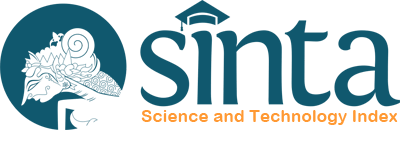DAILY ACTIVITY OF JUVENILE JAVAN GIBBON (Hylobates moloch AUDEBERT 1798) IN GUNUNG HALIMUN SALAK NATIONAL PARK
Abstract
Keywords
Full Text:
PDFReferences
Anonym (2017). Kota administrasi Jakarta Altmann J.(1974). Observational study of behavior sampling method. Behavior.(49) : 227-267.
Andayani, et al. 2008. Hylobates moloch. The IUCN Red List of Threatened Species 2008: e.T10550A3199941
Arief H.(1998). Teknik Pengamatan Primata. Bogor (ID): Institut Pertanian Bogor
Ario A.(2011). Aktivitas Harian Owa Jawa Rehabilitan di Blok Hutan Patiwel Taman Nasional Gunung Gede Pangrango. Kumpulan Hasil-Hasil Penelitian di Bodogol Taman Nasional Gunung Gede Pangrango (Conservation International Indonesia) periode 2000 – 2010.Jakarta (ID). CI Indonesia. hlm 13-30
Bekoff M. (1972). The Development of social interaction, play, and metacommunication in mammals: An ethological perspective. The Quarterly Review of Biology. 47(4):412-434
Bismark M. (1984). Biologi dan konservasi primata di Indonesia. [disertasi]. Institut Pertanian Bogor. Bogor (ID).
Boesch C, Boesch H. (1981). Possible causes of sex differences in the use of natural hammers by chimpanzees. J Hum Evol 13:415–440
Cambefort JP. (1981). A comparative study of culturally transmitted patterns of feeding habits in chacma baboons Papio ursinus and the vervet monkey Cercopithecus aethiops. Folia Primatologica. 36:243–263
Cheyne SM, Brulé A. (2004). Adaptation of a captive-raised gibbon to the wild. Folia Primatologica. 75:37-39
Chivers DJ. (1980). Malayan Forest Primates: Ten Years Study in Tropical Rain Forest. New York (US).
Clutton-Brock TH, Harvey PH.(1977). Species differences in feeding and ranging behaviour in primates. In: Clutton Brock TH, editor. Primate ecology: studies of feeding and ranging behaviour in lemurs, monkeys, and apes. London (GB): Academic Pr. p 557–584.
Dewi, M. C. (2016). Analisis karakteristik wilayah jelajah owa jawa (Hylobates moloch) di resor cikaniki Taman Nasional Gunung Halimun-Salak. [tesis]. Institut Pertanian Bogor. Bogor (ID).
Fagen RM, George TK.(1977). Play behaviour and exercise in young ponies (Equus caballus L.). Behavioural Ecology and Sociobiology. 2:267-269.
Fleagle JG.(1988). Primate Adaptation and Evolution. New York Academy Press.Harcout Brace and Company.
Geissmann T, Nijman V. (2006). Calling in wild silvery gibbons (Hylobates moloch) in Java (Indonesia) : behaviour, phylogeny, and conservation. American Journal of Primatology. 68 : 1-19
Goodall J.(1986). The chimpanzees of Gombe: patterns of behaviour. MA: Belknap Pr.673 p
Iskandar E. (2007). Habitat dan populasi owa jawa (Hylobates moloch Audebert, 1798) di Taman Nasional Gunung Gede Pangrango Jawa Barat. [tesis]. Institut Pertanian Bogor.Bogor (ID).
Kartikasari SN.(1986). Studi populasi dan perilaku lutung (Presbytis cristata Raffles) di Taman Nasional Baluran, JawaTimur [skripsi]. Institut Pertanian Bogor Bogor (ID).
Kummer H, Goodall J.(1985). Conditions of innovative behaviour in primates. Phil Trans R Soc Lond Ser B 308: 203–214.
Ladjar.(1996). Aktivitas harian dan penggunaan habitat pada keluarga owa jawa (Hylobates moloch Audebert, 1798) liar di Cikaniki, Taman Nasional Gunung Halimun, Jawa Barat. [skripsi]. Universitas Nasional Jakarta. Jakarta (ID).
Lambert JE.(2007). Primate nutritional ecology: feeding biology and diet at ecological and evolutionary scales. In: Campbell C, Fuentes A, MacKinnon KC, Panger M, Bearder SK, editors. Primates in perspective. New York (US) : Oxford University Press. 482 – 495.
Leighton M. (1987). Gibbons : Teritoriality and monogamy. Dalam Smuts et. al. (Eds.) Primate Societies. Chicago (US) and London (UK) : The University of Chicago Press.
Nakamichi M, Shizawa Y. (2003). Distribution of grooming among adult female in a large free-ranging group of japanese macaques. International Journal Primatology (24):607-625.
Napier JR, Napier PH.(1985). The Natural History of the Primates. The MIT Press Edition: Cambridge.
Nijman V.(2001). Forest (and) Primate: Conservation and ecology of the endemic primate of Java and Borneo, Kalimantan. Tropenbos, series 5 Palombit, r.A. 1997. Inter and intraspecificvariation in the diets of sympatric siamang (Hylobates syndactylus) and lar gibbons (Hylobates lar). Folia Primatol. 68: 321-337.
Oktaviani R. (2009). Studi perilaku bersuara owa jawa di Taman Nasional Gunung Halimun Salak Provinsi Jawa Barat. [skripsi]. Institut Pertanian Bogor. Bogor (ID)
Prastyono. (1999). Variasi Aktivitas Harian Owa Jawa (Hylobates moloch Audebert, 1798) di Taman Nasional Gunung Halimun [skripsi]. Bogor(ID): Institut Pertanian Bogor
Ravasi D. (2004). Phuket’s forest sings again. The Gibbon Rehabilitation Project Phuket: ii + 97 hlm.
Rowe N. (1999). The Pictorial Guide to the Living Primates. Pogonios Press : USA. Silk JB. 1987. Social behaviour in evolutionary perspective. In: Cheney BB, Seyfarth RM,Wrangham RW, Struhsaker TT, editors. Primate societies. Chicago (US): University of Chicago Press. 318–329.
Saroyo, S., Mansjoer, S. S., Tarumingkeng, R. C., Solihin, D. D., & Watanabe, K. (2006). Aktivitas Harian Monyet Hitam Sulawesi (Macaca nigra) di Cagar Alam Tangkoko-Batuangus, Sulawesi Utara. Majalah Ilmiah Biologi BIOSFERA: A Scientific Journal, 23(1), 44-49.
Sutrisno. (2001). Studi Populasi dan Perilaku Owa Jawa (Hylobates moloch Audebert, 1798) di Resort Cibiuk dan Reuna Jengkol Subseksi Taman Jaya Taman Nasional Ujung Kulon.[skripsi]. Institut Pertanian Bogor.Bogor (ID).
Suwandi A. (2000). Karakteristik Tempat Bersarang Orangutan (Pongo pygmaeus pygmaeus Linne, 1760) di Camp Leakey Taman Nasional Tanjung Puting Kalimantan Tengah [skripsi]. Institut Pertanian Bogor. Bogor (ID).
Umapathy G, Kumar A. (2000). The occurrence of arboreal mammals in the rain forest fragments in the Anamalai Hills, South India. Biological Conservation. 92:311-319.
Refbacks
- There are currently no refbacks.



